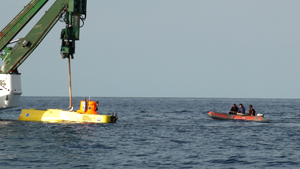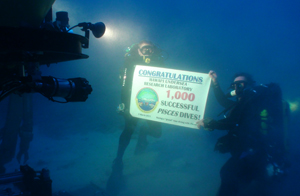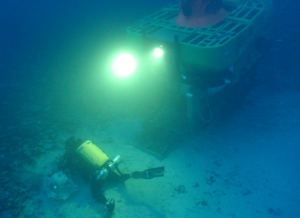
The R/V Ka'imikai-o-Kanaloa launches the Pisces V over her stern, while the chase boat stands by.
High resolution (Credit: With permission from R.L. Pyle.)
Nearly 500 students from in excess of 35 classrooms "virtually" accompanied researchers from the University of Hawaii and NOAA's Hawaii Undersea Research Lab (HURL) on the 1,000th dive by one of the lab's twin Pisces manned-submersibles. Since 1981, HURL researchers have spent nearly 9,000 hours underwater around the Pacific.
Students participating in Creep into the Deep: Virtual Research Mission to the Deep-sea communicated with scientists aboard the Pisces V submersible from classrooms around the country via email updates, photos and video. Creep into the Deep was developed in cooperation with WhaleTimes, Inc., NOAA's Office of Ocean Exploration and Research, and HURL to create a connection between elementary through high school students, ocean research, and marine scientists. This is HURL's 3rd Creep into the Deep mission.

Divers Dave Pence (left) and Ken Longenecker (right) hold up a banner commemorating the Hawai'i Undersea Research Laboratory's 1,000th dive with the Pisces submersibles.
High resolution (Credit: With permission from R.L. Pyle.)
Yvonne McCarty, a teacher at Felicita Elementary School in Escondido, Calif., wrote, "My 2nd grade class is so excited to be part of this amazing virtual tour. We are grooming future scientists and with this experience I can see that your team has sparked the interest in my students. Thank you for letting us set sail aboard with you. And congratulations on the 1,000 dives. Way to go!"
During the 1,000th dive, HURL researchers used the manned-submersible to study the growth rates and physiology of mesophotic reefs-reefs that occur in the deeper half of the photic zone, in this case 70 to 150 meters (approximately 230-500 feet) below the surface. They dove in the 'Au'au channel, off the island of Maui for a plan supported by NOAA's Center for Sponsored Coastal Ocean Research called Deep-CRES: Investigating the Deep Coral Reef Ecosystems of Hawaii.

Ken Longenecker swims down to the acrylic dome brought down by the Pisces V, and checks to make sure that the special pump is working correctly. The dome is used to apply a non-toxic stain to the Leptoseris coral head, to be used for measuring the growth rate of the coral over time.
High resolution (Credit: With permission from R.L. Pyle.)
HURL, established by N.O.A.A. and the University of Hawaii in 1980, provides cutting-edge, deep submergence capability throughout the Hawaiian Islands and U.S. Pacific territories. HURL operates Pisces IV and V, deep-diving submersibles capable of descending 2,000 meters (nearly 6,600 feet); the Research Vessel Ka'imikai-o-Kanaloa; remotely operated vehicle RCV-150; and a multi-beam mapping system. It also supports one of the biggest annotated video archives in the Pacific.
Commemorating ten years of ocean exploration, NOAA's Office of Ocean Exploration and Research uses state-of-the-art technologies to explore the Earth's largely unknown ocean in all its dimensions for the purpose of discovery and the advancement of knowledge.
NOAA's mission is to understand and predict changes in the Earth's environment, from the depths of the ocean to the surface of the sun, and to conserve and manage our coastal and marine resources. Find us on Facebook.

